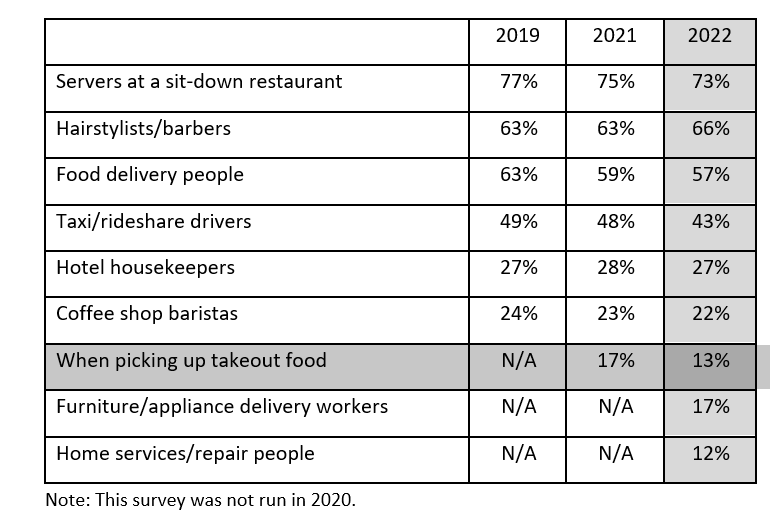Payroll
People are Tipping Less Since Covid
The number of U.S. adults who say they always tip for services (servers at a sit-down restaurant, hairstylists/barbers, food delivery people, taxi/rideshare drivers, hotel housekeepers, coffee shop baristas and when picking up takeout food) has ...
Jun. 08, 2022

Although many Americans vowed to become better tippers because of the financial impact of Covid-19 on service industry employees, new data from CreditCards.com shows they have failed to follow through.
The number of U.S. adults who say they always tip for services (servers at a sit-down restaurant, hairstylists/barbers, food delivery people, taxi/rideshare drivers, hotel housekeepers, coffee shop baristas and when picking up takeout food) has declined in every category except one. The exception: Roughly two-thirds of Americans (66
Tipping a server at a sit-down restaurant is the most common service for which these Americans say they always tip (73%). However, that response varies quite a bit by generation and gender. Just 52% of Gen Zers (ages 18-25) and 60% of millennials (ages 26-41) always tip restaurant servers, compared with 77% of Gen Xers (ages 42-57) and 87% of baby boomers (ages 58-76). Women (78%) are more inclined to always tip their waitstaff compared to just 68% of men. Overall, besides the 73% who always tip, 14% of these U.S. adults say they tip their servers most of the time, 9% sometimes and 4% never give them a tip.
While there seems to be a clear consensus that waitstaff should be tipped, there is quite a bit of confusion about whether or not people should be tipped for providing other services. Here’s how often those Americans who use each of the following tip the other service providers listed in the survey:
- Taxi/rideshare drivers: 43% always/23% most of the time/21% sometimes/13% never
- Hotel housekeepers: 27% always/21% most of the time/27% sometimes/26% never
- Coffee shop baristas: 22% always/22% most of the time/33% sometimes/22% never
- Furniture/appliance delivery workers: 17% always/19% most of the time/23% sometimes/41% never
- When picking up takeout food: 13% always/17% most of the time/30% sometimes/39% never
- Among those who tip at sit-down restaurants, the average is 21% (up from 19% in 2019 and 20% in 2021) and the median is 20% (the same as in 2019 and 2021).
While the median is 20% for all generations, the averages are much higher for Gen Zers (26%) and millennials (24%). Gen Xers leave an average tip of 20% and boomers give 19% on average. But remember, over four in ten (43%) combined Gen Z and millennial restaurant goers leave nothing at least some of the time. These figures are among those who tip.
The tip means increase with income (from 19% under $50,000 in annual household income to 21% between $50,000 and $79,999 to 22% between $80,000 and $99,999 and 26% at $100,000+). The median for all those income groups is 20%, except the lowest bracket is 18%.
Men and women both give a median tip of 20% at restaurants, but the average is a little higher among men (22% vs. 20% for women). This is another instance, though, of a group (men, in this case) tipping a little better on average but also being more likely to leave nothing.
It has become somewhat commonplace to be offered a “suggested” tip amount by the establishment or service provider when paying the bill. Among people who have encountered suggested tip amounts (for example, at a coffee shop, a food truck, a taxi/rideshare, etc.), most (62%) say their tipping habits are about the same. More than a quarter (26%) are inspired to tip more (7% much more + 18% somewhat more), while 12% tip less as a result (5% much less + 7% somewhat less).
Younger generations are more likely to be impacted by the suggestions. Gen Zers (40%) are the most likely to tip more after seeing these recommendations, followed by millennials (37%), Gen Xers (22%) and boomers (14%).
